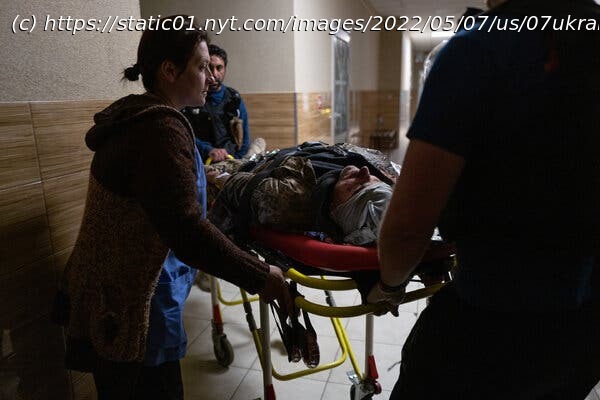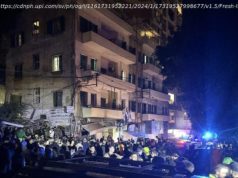Kyiv May 8, 12:30 a.m.
Moscow May 8, 12:30 a.m.
Washington May 7, 5:30 p.m.
Both sides were trying …
Kyiv May 8, 12:30 a.m. Moscow May 8, 12:30 a.m. Washington May 7,5:30 p.m. Both sides were trying to take territory in the run-up to Russia’s Victory Day, when the Kremlin would like to tout the invasion’s progress. President Volodymyr Zelensky called on citizens to heed local curfews and not ignore air raid sirens. Dan Bilefsky and Cora Engelbrecht With less than 48 hours before the Victory Day holiday commemorating the Soviet vanquishing of Nazi Germany, Russian forces were being pushed back near Kharkiv, Ukraine’s second-largest city, underlining the challenge facing President Vladimir V. Putin as he tries to portray a triumph to the Russian people in an increasingly grinding war of attrition. Russian forces blew up three bridges over the last 24 hours, Ukrainian officials said, as they were forced back toward the northeast border of Kharkiv, a major target of their offensive since the war began. The sprawling city just 25 miles from the Russian border has important strategic and symbolic resonance for the Kremlin because it is closer to Russia than any other large Ukrainian city, has a large Russian-speaking population, and has been presented in the Kremlin’s version of history as a place that demonstrates the folly of Ukraine trying to live apart from Russia. Ukrainian forces have retaken a constellation of towns and villages in the outskirts of Kharkiv this week, putting them in a position to unseat Russian forces from the region and reclaim control of the city “in a matter of days,” according to a recent analysis by the Institute for the Study of War, a military research group in Washington. Ukrainians were bracing on Saturday for a potentially fierce Russian assault amid speculation that Victory Day could be a possible turning point in Moscow’s offensive. Russian forces have been fighting hard to advance in the face of tough resistance from Ukraine, newly emboldened with weapons supplied by the United States and the West. Underlining the fragile sense of normalcy returning to some parts of Ukraine, President Volodymyr Zelensky implored citizens in his Friday night address to be vigilant and heed local curfews and air raid sirens with the threat of Russian attacks looming. “Please, this is your life, the life of your children,” he said. In other developments: After three days of civilian evacuations from Mariupol’s besieged Azovstal steel plant, Iryna Vereshchuk, Ukraine’s deputy prime minister, said on Saturday that all women, children and elderly people had been rescued from the complex. There was no immediate confirmation from the Red Cross, which earlier Saturday said evacuation efforts were “ongoing.” Russian forces are trying to break through Ukrainian lines and encircle troops defending the area around the eastern city of Sievierodonetsk but are for now being held in check, the regional governor said Saturday. Jill Biden, the first lady, met with Ukrainian refugees in Romania on Saturday, listening to harrowing stories from women who fled Russian bombs and visiting with children as young as five. President Biden is sending a new security package to Ukraine worth $150 million that will include 25,000 artillery rounds, counter-artillery radar and other field equipment, according to an administration official. The Italian authorities said they had impounded a nearly $700 million superyacht, the Scheherazade, which is reportedly owned by a man with close links to Mr. Putin. The yacht had shown signs of preparing to set sail, apparently to avert the seizure. Alan Yuhas The regional governor of Luhansk in eastern Ukraine, Serhiy Haidai, said on Facebook that a Russian bomb hit a school in the village of Bilogorivka where about 90 people had taken shelter. About 30 people have been rescued so far, he said. The bodies of at least two people were recovered from the rubble, according to Ukraine’s State Emergency Service. Rescue operations were suspended on Saturday night and were to resume on Sunday, officials said. Cora Engelbrecht and Michael Schwirtz All the women, children and elderly people who were trapped for weeks in the besieged Azovstal steel plant in Mariupol have been evacuated, Russian and Ukrainian officials said on Saturday, after days of start-and-stop efforts to get the last civilians out. “This part of the Mariupol humanitarian mission has been completed,” Ukraine’s deputy prime minister, Iryna Vereshchuk, said on Telegram. Her statement did not provide further details. Hours later, Russia’s Defense Ministry said in a statement that “a humanitarian operation to evacuate civilians” from the complex was completed on Saturday, with help from representatives of the United Nations and the Red Cross. The office of President Volodymyr Zelensky of Ukraine thanked the two international groups for helping with the “first phase” of evacuations. The office said on Telegram that the civilians who had been in the plant were rescued, more than 300 in all. The next goal would be to evacuate the wounded and medics, the office said. There were no immediate details from Mariupol city officials, the Red Cross or the United Nations, which have been helping to coordinate recent evacuations from the steel factory, the last holdout of Ukrainian fighters in the ruined southern city. A spokeswoman for the Red Cross earlier on Saturday had said efforts to evacuate the remaining civilians were “ongoing.” About 50 civilians were evacuated in a humanitarian convoy on Friday, and officials said at the time that about 200 were still believed to be holed up with the last Ukrainian fighters in the devastated complex. Despite the mediation of international groups, there was still bloodshed, a Ukrainian official said. Three Ukrainian soldiers were killed during an evacuation attempt from Azovstal, according to Mikhailo Vershinin, the chief of the city’s patrol police. He said six other soldiers were wounded, some seriously. “In the hospital there is no medicine, no anesthesia, no antibiotics and they may die,” he said in a voice message. Petro Andriushchenko, an adviser to Mariupol’s City Council, said on Telegram that it was incomprehensible for soldiers to be killed “in the middle of an evacuation.” “Politicians and world leaders are thanking each other for the successful evacuation of civilians,” he said on Telegram, adding that the Ukrainian soldiers “gave their lives for others to enjoy the fresh air.” Evacuation efforts so far have not taken out Ukrainian fighters, many of whom are believed to be wounded. The Azovstal steel plant is the last bastion of resistance in Mariupol and has come under heavy bombardment from Russian forces. On Saturday, Ukraine’s military said Russian forces were continuing to conduct “assault operations” in the area of the Azovstal plant, backed by artillery and tank fire. Russian officials had declared a three-day cease-fire, starting on Thursday, to allow more civilians to exit the complex, though Ukrainian officials have accused Russian forces of attacks despite that announcement. The United Nations and Red Cross teams have managed to extricate some 500 civilians in recent days from Mariupol, according to António Guterres, the U.N. secretary general. Those who have made it out have shared harrowing accounts of the weekslong siege they had endured, describing how they had sheltered in the near-darkness of underground bunkers, with little food or water, as explosives of all shapes and sizes rained down day and night, slowly chipping away the steel and concrete overhead that was their only protection. Ivan Nechepurenko contributed reporting. Julian E. Barnes The current phase of the war in Ukraine, as Russia focuses on trying to capture the country’s east and south, could prove at least as dangerous as Moscow’s first failed attempt to quickly seize major northern cities and topple the government, the C.I.A. director, William J. Burns, said on Saturday. The stakes are just as high in this phase, in large measure because President Vladimir V. Putin of Russia is “in a frame of mind that he thinks he cannot afford to lose,” Mr. Burns said. Mr. Burns, a former U.S. ambassador to Russia, has studied Mr. Putin for decades and in recent appearances has spoken about the risks the Russian president is willing to take to exert control over Ukraine. “He’s convinced right now that doubling down still will enable him to make progress,” Mr. Burns said, speaking at an event in Washington sponsored by The Financial Times. Mr. Burns repeatedly praised Ukraine’s fierce resistance to the Russian invasion, arguing that Mr. Putin’s biggest mistake so far in the war was to underestimate the Ukrainians’ will to fight and their ability to defend themselves. Mr. Burns did not discuss in detail the American intelligence provided to the Ukrainians. Senior U.S. officials have said U.S. intelligence had helped Ukrainian forces target high-ranking enemy officers and sink Russia’s flagship in the Black Sea. But Mr. Burns said Ukrainians have supplemented the information they have received from American intelligence with their own knowledge and insights. “It’s a big mistake to underestimate the significant intelligence capabilities that the Ukrainians themselves have,” Mr. Burns said. “This is their country. They have a lot more information than we do.” Mr. Burns said China was closely monitoring the events in Ukraine, both the country’s strong resistance and the economic sanctions imposed on Russia by the international community. The Russian invasion has not eroded the ambitions of President Xi Jinping of China to take control of Taiwan, he said. But Mr. Xi and other Chinese leaders, he added, are trying to look carefully at what lessons to “draw from Ukraine about their own ambitions and Taiwan.” Mr. Burns said the C.I.A. spends a lot of time focusing on China’s reaction to the war in Ukraine and Beijing’s relationship with Moscow. He suggested driving a wedge between the two countries would not be easy. “I would not underestimate Xi Jinping’s commitment to his partnership with Putin’s Russia,” Mr. Burns said. Roger Cohen In the past, President Vladimir V. Putin of Russia has used the annual celebration of the Soviet victory over the Nazis in 1945 to cement his steady militarization of Russian society, extol the values of heroic patriotism, and contrast Russia’s warrior spirit with what he sees as the moral decadence of the West. This year, he will no doubt try to conjure “victory” from the indiscriminate destruction he has wrought in Ukraine. He will find some justification for a war that has gone far less well than expected against a Western-backed “Nazi” threat in Kyiv that he has invented. As he does so, May 9 will be marked otherwise in Western Europe. President Emmanuel Macron will salute Europe Day in Berlin and Strasbourg, seat of the European Parliament, laying out his ambitious vision of a 27-nation European Union now compelled to move beyond mere economic heft toward becoming a more federal, and more forceful, world power. “It will be a split-screen effect,” said Nicole Bacharan, a French foreign policy analyst. “On one screen, a magnificent Moscow military parade, on the other something more cumbersome and slow, but perhaps we in the European Union should celebrate not having a dictator laying down the law.” Two Europes now face each other on a continent where, for Mr. Putin’s Russia, the defeat of Nazi Germany in the “Great Patriotic War” enshrines the sacredness and glory of war, whereas in Paris and Berlin it symbolizes the imperative of peace. The confrontation is between 19th- and 21st-century worldviews, with potential consequences that the 20th century illustrated at Verdun, Hiroshima and elsewhere. Mr. Putin’s war in Ukraine has demonstrated that the risk of great conflagrations has not been consigned to the past. Cora Engelbrecht Iryna Vereshchuk, Ukraine’s deputy prime minister, said that all women, children and elderly people had been evacuated from Mariupol’s Azovstal steel plant. Her statement, posted on Telegram, did not provide further details. There was no immediate confirmation from the Red Cross, which earlier Saturday said efforts to evacuate the remaining civilians were “ongoing.” Julian E. Barnes C.I.A. Director William J. Burns said that the new phase of the Ukraine war, with Russia’s offensive in the country’s east, is at least as dangerous as the first parts of the invasion. Speaking at an event in Washington sponsored by the Financial Times, Burns said that President Vladimir V. Putin of Russia is “in a frame of mind that he thinks he cannot afford to lose,” and so the stakes are high. Cora Engelbrecht Efforts to retrieve the remaining civilians from the Azovstal plant in the southern city of Mariupol were “ongoing” on Saturday, according to a spokeswoman for the Red Cross, which worked with the U.N. to coordinate the first large evacuation from the steel complex this week. The spokeswoman would not share further details “until the situation allows, as it could seriously jeopardize the operation,” she said in a statement. About 50 civilians were evacuated in a humanitarian convoy on Friday, while about 200 were holed up in the last bastion of Ukrainian resistance in the city. Michael Schwirtz Three Ukrainian soldiers were killed on Friday during an attempt to evacuate civilians from Mariupol’s Azovstal steel factory, said Mikhailo Vershinin, the chief of the city’s patrol police. Vershinin, who is at the factory, said a rocket and a grenade were to blame. “Six were wounded, some seriously,” he added in a voice message on Saturday. “In the hospital there is no medicine, no anesthesia, no antibiotics and they may die.” David Guttenfelder Workers operate an iron ore mine belonging to the Metinvest Group in Kryvyi Rih, Ukraine. The company also owns the Azovstal steel plant in Mariupol, where beleaguered Ukrainian soldiers have been trapped by Russian troops along with many civilians. The iron and coal industries have shaped the history of southeastern Ukraine, which has become the war’s main arena. Cora Engelbrecht Russia launched six missiles at Odesa, the city council said in a statement. There were no immediate reports of casualties. Four missiles targeted a furniture company and damaged two nearby high-rise buildings, the council said, adding that the other two missiles hit the city’s airport, which had already been demolished in a separate strike. Roger Cohen In his inauguration speech, President Emmanuel Macron of France vowed to “act first to avoid any escalation following the Russian aggression in Ukraine.” Macron made clear that he would fight so that “democracy and courage prevail” in the struggle for “a new European peace and a new autonomy on our continent.” Michael Schwirtz Russian forces are trying to break through Ukrainian lines and encircle troops defending the area around the eastern city of Sievierodonetsk but are for now being held in check, the regional governor said Saturday. “It is a war so anything can happen, but for now the situation is difficult but under control,” Serhiy Haidai, the regional governor, said in a telephone interview. “They have broken through in some places and these areas are being reinforced.” Russia’s military is looking to take Sievierodonetsk or cut the city off from the bulk of Ukrainian forces fighting in the east, and continue a push south to the major industrial city of Kramatorsk. The ultimate goal is to seize as much of the eastern Ukrainian region known as the Donbas as possible by expelling Ukrainian forces from the two eastern provinces of Donetsk and Luhansk. Russia instigated a war in 2014, backing a separatist army that established two breakaway territories that encompassed about a third of the Donbas. Since Russia’s invasion began on Feb.24, about 80 percent of the provinces have fallen under the Kremlin’s control. To achieve the current aim of controlling the Donbas, Mr. Haidai said, Russia’s military has deployed units with better training and more combat experience than it deployed earlier in the war. “In the beginning, they sent in newly-mobilized soldiers from occupied territory,” he said. “But they can’t fight. They aren’t dressed in flak jackets. And so they just died by the dozen or the hundred. But they’re running out of these.” Mr. Haidai said he had urged anyone who could to evacuate, but that about 15,000 people have remained in Sievierodonetsk. Some of those are the elderly, he said, “who want to die in the place where they were born.” Others, he added, are “just very stubborn, people whom you can’t convince to leave.” “They want to stay in their homes and apartments. Unfortunately they start thinking seriously about evacuation only when there is constant shelling and fighting directly in the city,” he said. Cora Engelbrecht and Michael Schwirtz Russian forces stepped up attacks in the northeast on Saturday in an effort to thwart a Ukrainian offensive that has started to force Russian units away from the outskirts of Kharkiv, a sprawling city about 25 miles from the Russian border. Ukraine’s General Staff reported a flurry of Russian attacks on Friday in several regions near Kharkiv that were meant to “slow down the counteroffensive,” including strikes on three bridges near the villages of Ruski Tyshky and Tsyrkuny, about 12 miles northeast of Kharkiv. A senior Ukrainian official, speaking on condition of anonymity to discuss the fighting, said Russian forces were destroying bridges not to retreat but because “we are pushing them out.” He said the fight for Kharkiv was not over, and that although “at the moment we are dominating,” Russian forces were trying to regroup and go on the offensive. “They’ve been doing this since the night of May 4,” he said. “In some places they succeed. In some places they don’t. They control a large part of Popasnaya and Rubezhnoe and Severodonetsk is under real threat.” The Russian military’s destruction of bridges mirrored its exit last month from the city of Chernihiv, north of Kyiv, said Frederick W. Kagan, a military historian and a senior fellow at the American Enterprise Institute, a Washington-based research group. It could be an indicator that “the order to retreat to somewhere had been given and they were trying to set up a defensive line,” he said. Russia’s Defense Ministry said on Saturday that its military had struck a large “military facility” overnight near a railway station in the village of Bohodukhiv, about an hour northwest of Kharkiv. The facility was housing “a large accumulation” of military equipment from the United States and European countries, the defense ministry said. The back-and-forth battles have left an increasing number of towns and cities trapped in a “gray zone,” stuck between Russian and Ukrainian forces and subject to frequent shelling. “The Russian occupiers continue to destroy the civilian infrastructure of the Kharkiv region,” the region’s governor, Oleh S inegubov, said in a Telegram post on Saturday, adding that shelling and artillery attacks overnight had targeted several districts, destroying a national museum in the village of Skovorodynivka.
Домой
United States
USA — Political All women, children and elderly people have been evacuated from Mariupol’s steel...






